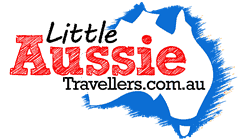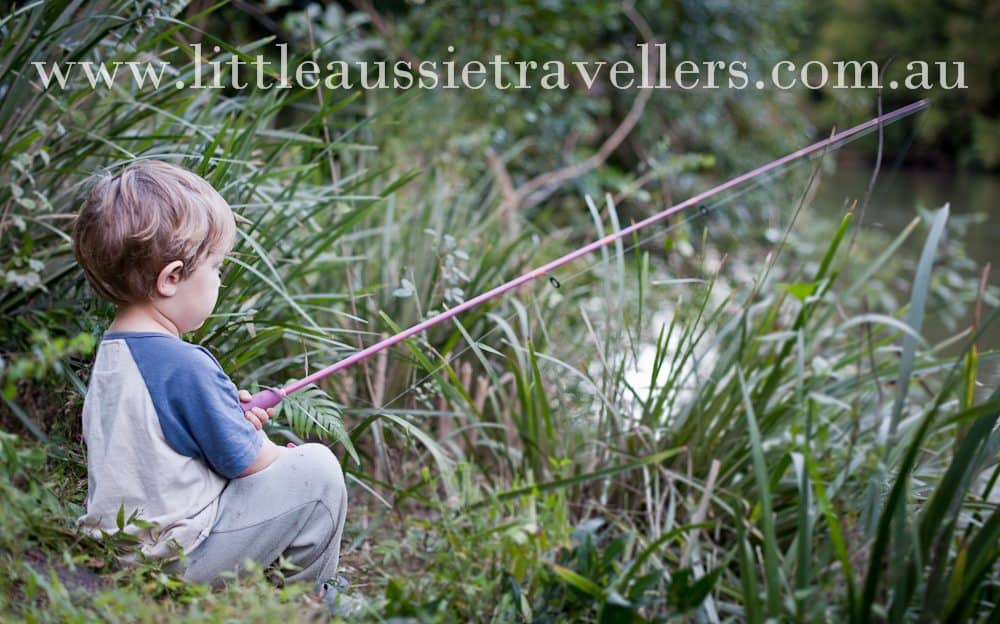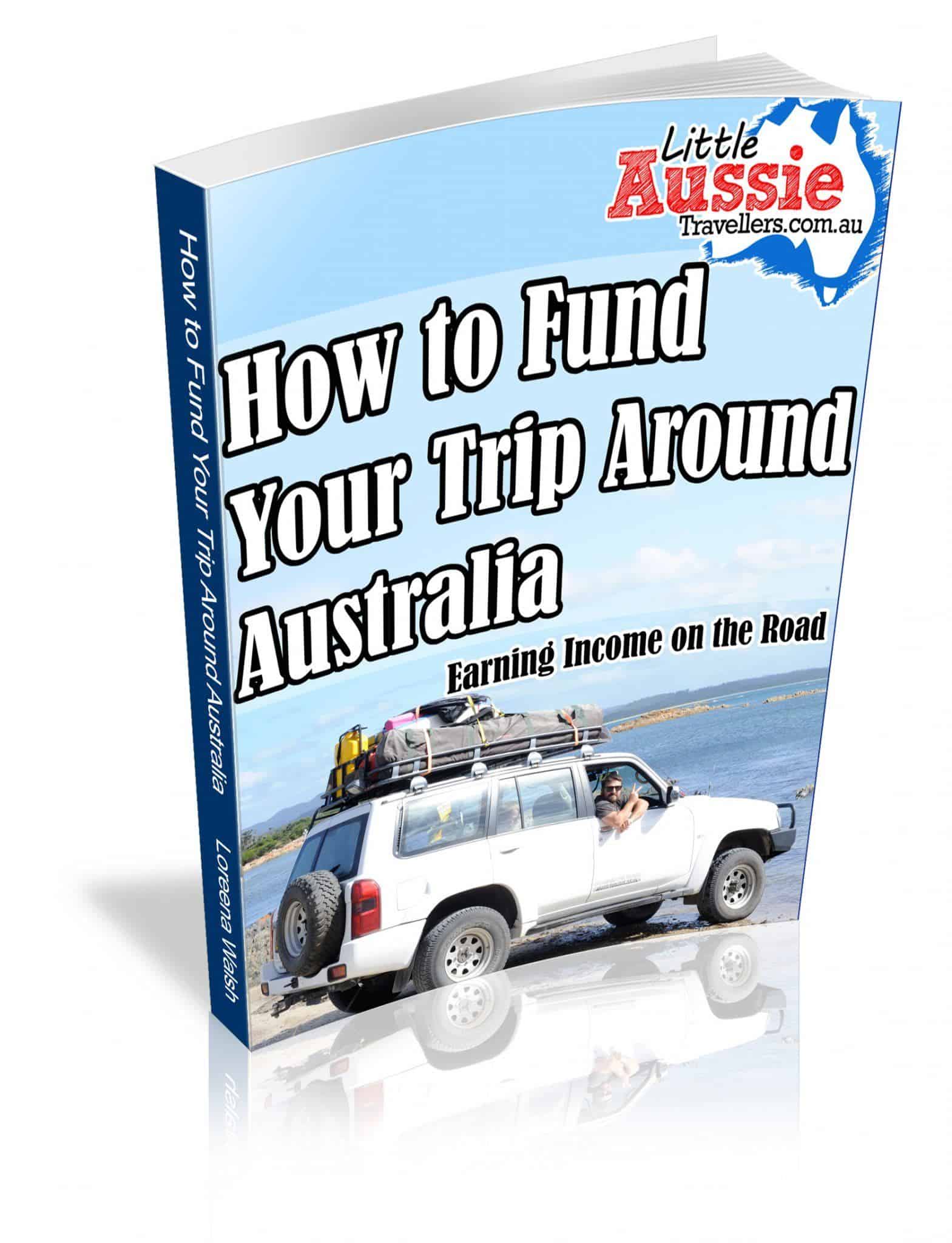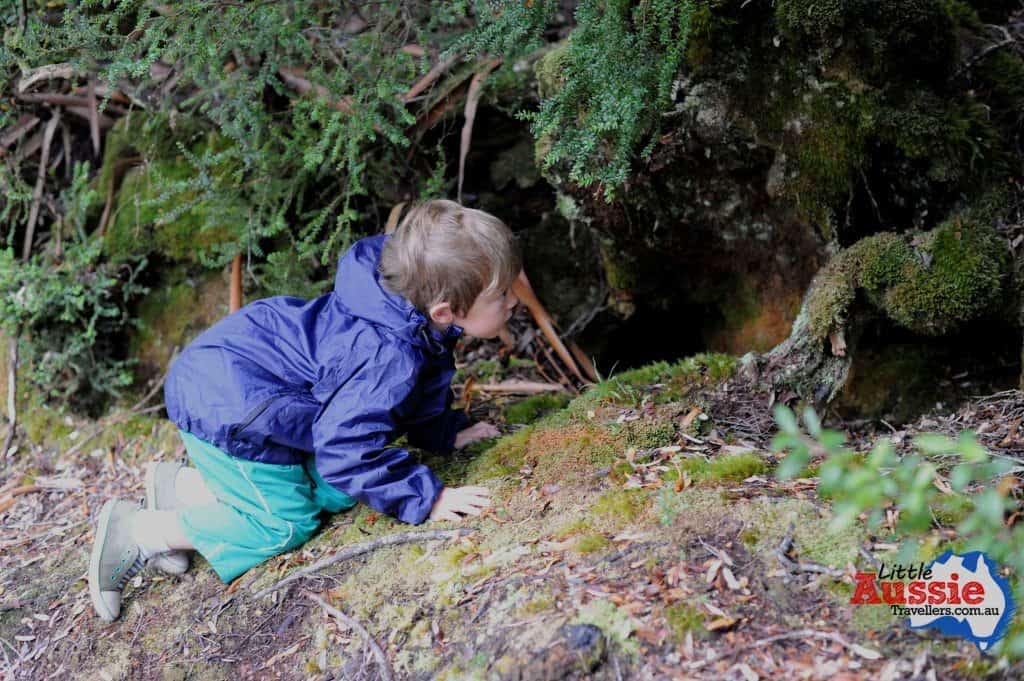
by Loreena Walsh | Camping
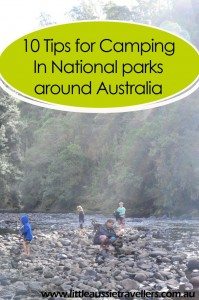
We’re really blessed with so much variety available for Australian holidays with options available for beach side fun to dry deserts, but one of my favourite things to do when travelling is to visit our National Parks.
Obviously because we are travelling Australia with our dog, our time camping in National Parks is limited, but before we were travelling full time it was one of our favourite ways to get out into nature, and during our time on the road we’ll kennel Yoshi when we need to because there’s some National Parks in Australia that are just too amazing to miss.
If you want to head out camping in National Parks, here’s our top tips:
1. Please DO NOT take pets and animals into National Parks.
It’s crazy the number of times we’ve done day trips or camping trips into National Parks, only to see people there with dogs or other pets. While as people travelling with a very well behaved dog we’d love it if we could take him with us, the rules are very simple: NO PETS ALLOWED.
This is for a good reason; The purpose of National Parks is to protect the fauna and flora inside them, and dogs not only scare the wildlife, but they can carry disease and attract other dogs into the area. Escaped pet dogs are also the cause of Australia’s large number of wild dog populations which decimate wildlife and cattle across the country.
2. Some Camping in National Parks is Free, Some is not.
It’s important to check out if the National Park you want to camp in is free, or is paid and requires bookings. While many of the more remote campgrounds are free and made available on a first come first served basis, for some of the more popular National Park campgrounds pre-booking may be necessary, especially in peak periods.
3. Some National Parks Require Passes for Entry.
In more regulated tourist areas it’s likely you’ll need an entry pass into the National Park. Some National Parks are available for people to come and go as they please, while others will have options for day visitors to purchase an entry pass. When payment is required, there will usually be a payment box that allows you to take an envelope and pay your days entry and acquire a pass to show on your vehicle.
4. Each State of Australia has Different National Parks Requirements.
It’s not possible to purchase a single pass that covers you for all National Parks. When you’re planning to head to a State, our advice is to check out the website for that state’s National Parks and research the requirements and the passes available. When we were in Tasmania it was cheaper for us to purchase a 60 day pass as we’d be visiting a couple of National parks over our time there than it was to purchase separately for the days we’d be entering, this is often the case.
5. Leave Camp Areas Clean or Cleaner than You Find Them.
National Parks are an important part of conservation of Australia’s plants and animals and when you visit them, you may find there aren’t any rubbish facilities. It could be that they are remote, or just financially it isn’t possible to provide rubbish services. PLEASE take your rubbish with you. If you find a campsite in a mess, notify a ranger if you bump into one, or call the National Parks office for the state you’re in to let them know; alternatively clean up what you can and take it with you.
6. Don’t Mess With The Natural Environment.
If it wasn’t introduced by visitors, then don’t take it out of the National Park. It is illegal to remove flora and fauna from a National Park, and while it might not seem like a big deal for one person to do it, if every visitor took something they found it would have horrible consequences. The same goes for firewood. Please don’t fell trees or use fallen timbers for fire wood; it’s important for the eco system that wood isn’t removed from the habitat.
7. Don’t Feed The Wildlife
It’s also important not to feed the animals, although this doesn’t just apply in National Parks, it applies to anywhere in nature that you’re camping around native wildlife. Not only does feeding the animals pose a risk to their health and can make them sick, it can also familiarise them to humans and make them more confident in approaching camps. For animals who can pose a threat to humans, if they become too placid they can become food aggressive and may need to be euthanized to keep the area safe. Not feeding the animals prevents innocent animals having to be put to sleep.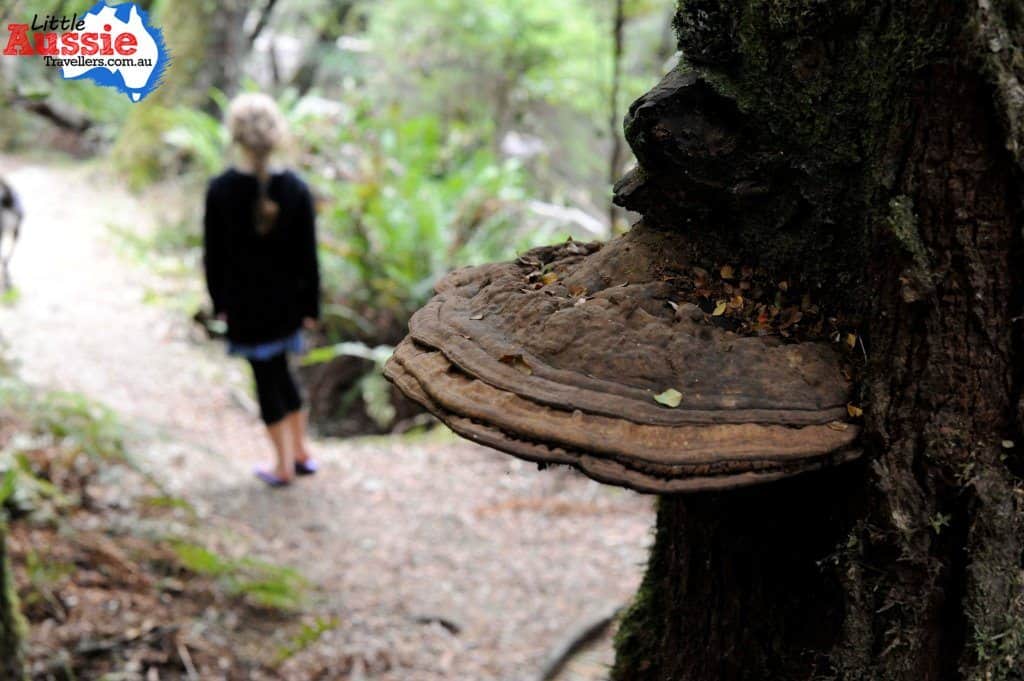
8. Stay Tidy or You’ll Regret It.
Trust us on this one: Keep your rubbish and food packed neatly away. While you’re snoozing of a night, lots of animals will come out to play, and it’s your food and goodies they’ll be excited to rummage through. If you don’t keep your rubbish out of reach of the animals, you can rest assured you’ll wake in the morning to find it strewn across your campsite. If you don’t pack your food in animal proof containers, then don’t expect it to be waiting for you to eat the next day. Animals aren’t silly and they’ll take any opportunity you give them to grab your goodies.
9. Take Everything You Need With You.
Most National Parks won’t have facilities for you to purchase food, and in many cases won’t even have water access points. Please be sure you have enough supplies on hand, especially drinking water as it can sometimes be quite a distance to get to a town for supplies. You’re going to have to be totally self sufficient for the most part, this could also mean there aren’t toilets available so you’ll need to take your own or get comfortable with safely digging your own bush toilet. Bush showering is also likely for long stays although more popular National Parks have some kind of toileting and showers available although often cold. Here’s some of our camping tips if you’re not familiar with camping remotely.
10. Enjoy and Be Safe.
Just get out there and explore, enjoy and follow the paths. Don’t go wandering into areas without designated paths unless you’re highly familiar with the area and know what you’re doing. Do, sign on for walking registers. For more popular National Parks there are registration sheets to help rangers track walkers to ensure that everyone returns safely. Do go prepared with plenty of water, snacks and a first aid kit including a snake bite bandage. Take photos, video, make memories and have fun, we’re blessed to have such amazing outside places to explore.
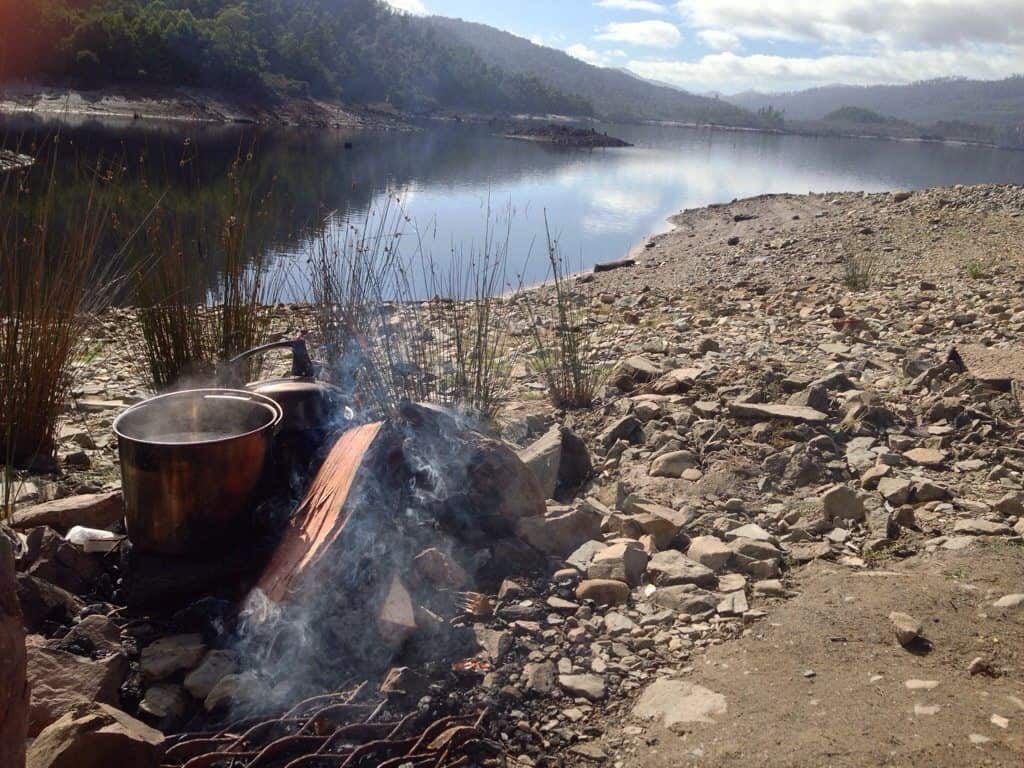
by Loreena Walsh | Camping, Gear Guide
One of the big considerations when you decide to travel, especially if you aim to free camp, is having showers and staying clean. Gone will be the days of unlimited streaming hot water, and long hot baths, but it’s really just a case of being practical, thrifty and sensible and once you find your groove it’s not too hard at all. We get lots of emails asking about shower set ups for free camping and travelling on long term family holidays, so here’s some starting pointers.
Options for keeping clean quickly while travelling?
Quick and Easy Travel Hygiene
Let’s get honest here, some days it’s just not possible to have a full wash. It may be too cold, you may be driving all day and not arrive to camp until late, or there’s just such limited water having fresh drinking water is more important. Never fear, you can always freshen up if you carry 2 important items:
1: Baby wipes
2: Hand Sanitiser – The water-free kind.
Baby wipes are great for an all over clean up, or just the vital areas. Hand Sanitiser allows you to ensure your hands are clean and hygienic, so a combination of these works great for a light freshen up.
Water Saving Travel Bath
It’s surprising how effective a sponge bath can be. This is a common option for campers and travellers when there isn’t another option.
A small bucket or large bowl can be filled with warm water and a face washer or cloth is all you need to get a thorough clean. For travelling families who need a little privacy a shower tent is a great idea.
Another handy thing to know is that using sensitive skin, soap free options will still clean you but you don’t have to worry about the skin-drying soap residue if you don’t have running water to rinse with.
Camp Showers while Travelling
The ultimate in shower options for Travellers and campers is to imitate a “real” shower as closely as possible, and this is where camp showers come in.
There’s several levels of luxury and lots of options available, so here goes:
Solar Shower Bags For Campers
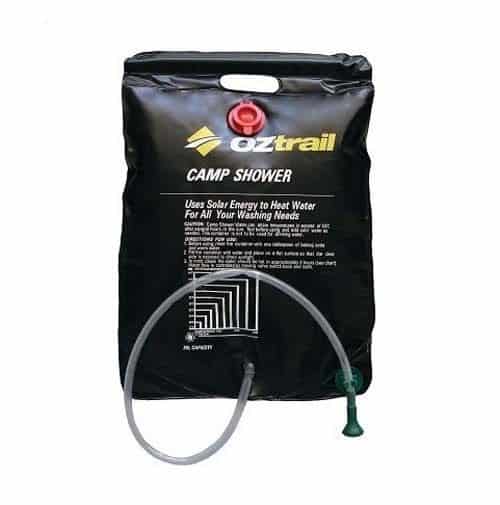
This option is a tried and true remedy for accessing heated shower water when camping. Black rubber bags are laid in the sun for a natural heating method. It’s best suited to when you are staying more than one night as the water bladder will need to lay in the sun for the day. Similarly it’s better for warm regions as the bags won’t heat properly on cold, overcast, rainy days.
12 Volt Shower & Heat Your Own Water
Of all travelling families we’ve spoken to, this option is probably one of the most common options for showering while camping. It’s simply the use of a portable 12 volt shower pump.
Heat up some water, over the camp fire is a great option for saving gas and making the most of the fire, other than that, just on the gas stove will do.
Mix the hot water into a bucket with some cool water until it’s the right temperature and then use this and the portable shower to wash.
12 Volt showers are mostly hooked up to a battery, either the car, or a spare to run the shower pump which is immersed in the bucket of warm water.
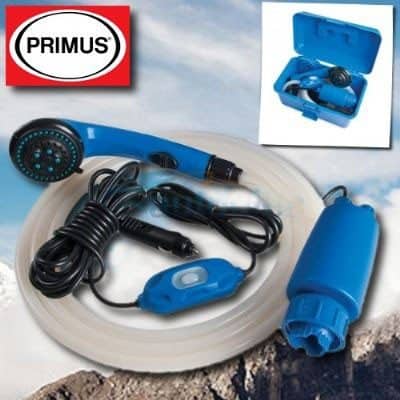
Complete Hot Water Units.
For those who don’t want to worry about having to pre-heat water, the use of a hot water service offers even more convenience. You’ll still need a bucket of water, but instead of having to preheat, the 12 volt shower runs as part of the hot water service, which has an adjustable temperature gauge on it. Brands such as Coleman hot water on demand, and Companion Aquacube are popular choices.
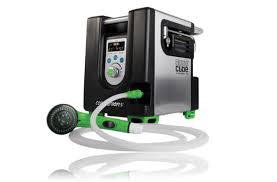
Top Tips for Camp Showers
The vital ingredient for this type of shower is the shower tent. These range from pop-up kinds to more sturdy dual ensuite options. Regardless of which one you purchase, it will provide welcome privacy for both a shower, and if you carry one, a portable toilet.
It’s a great idea to put some foat matting at the bottom of your shower tent to keep your feet clean and allow the water to run away. This type of matting is available at camping and discount stores.
When camped near a clean power supply such as a river or lake, this will allow you to use available water supplies instead of water that’s better saved for drinking and cooking. If you can make out in our photo here, we’ve got 3 pots of water on the fire to save on the gas so we could have enough hot water to wash everyone. It took a few rounds of water, but the water from the lake was fresh and beautiful, and it was a lovely warm day, perfect for a good clean up for the kids.
What tips do you have for camp showers while travelling?
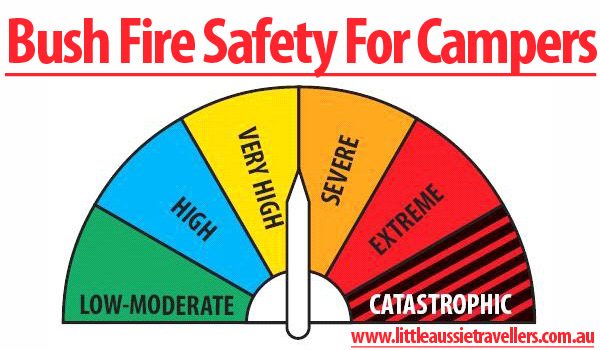
by Loreena Walsh | Camping, Slider Features
Australia has been in the grips of a heat wave in the past week or two with fire risk across the country. If you’re wanting to enjoy some family camping outdoors, then it’s super important that you understand the basics of bush fire safety for campers. With National Parks recently closed, and total fire bans across most of Australia, there have still been reports of travellers putting themselves in fire danger.
Camping during summer is great, but it’s important that you understand what to do if a fire threat occurs. It’s also important to know how to prevent starting an accidental fire at your campsite.
Bush Fire Safety Preparation For Campers
- Check for current fires: Using websites such as Landgate Fire Watch will help you track current fires burning in the areas you wish to camp in. They also list a range of other bushfire information services on their website below the current fire map.
- Be aware: While driving through the bush it pays to be aware of your surroundings. If you’re heading to a remote area or dry bush land and it’s a hot day, then the chances of a fire increase dramatically. Keep a look out for smoke, talk to rangers if you see them in camp areas or National Parks and check any signs that may reflect current fire danger risks.
- Carry suitable supplies: While singlets, shorts and swimmers are generally common camp gear, if you find yourself trapped in a bush fire area in the middle of summer, these clothing options will put your life in danger. Even in the hottest weather, you need to be prepared by carrying with you; long pants, a long sleeved shirt, hat and gloves made from natural fibres, along with glasses and boots. Wearing these items helps to protect your body from the deadly radiant heat that exists during a fire. Carrying a woollen blanket and plenty of water is also a great idea.
This may sound over the top, but the reality is, if you’re camping on hot days, in a region that has the possibility of being affected by fire, these items could save your life.
- Tell someone where you are going: If you’re heading off into bushland to camp, then let someone know exactly where you are going and for how long. In times of fire, communications can be cut from areas making it impossible for you to make contact in times of an emergency.
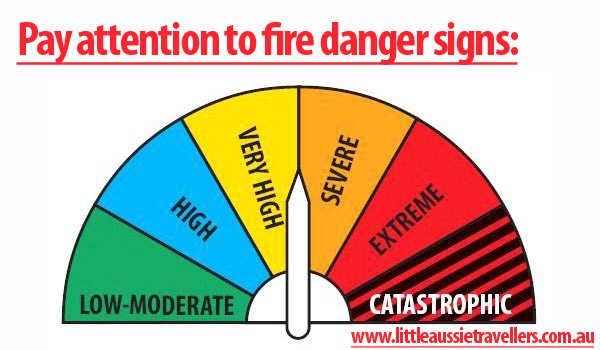
Basics of Bush Fire Safety For Campers.
- Is there a fire ban? It’s your responsibility when you’re camping to find out if there is a total fire ban in place. If there is, you will not be able to have a camp fire, or any naked flame. This needs to be taken very seriously, as it only takes one small mistake or disregard for the laws to cause major bush fires that threaten life and property. You can find fire ban details at the fire authority in your state.
- Preparing and lighting a camp fire: When you light your camp fire, make sure you do it in a cleared area or a dedicated fire pit. Do NOT place rocks around the edge of your camp fire as they can explode!
- Try to leave at least 3 metres between your fire and camp gear, and in a windy area try to keep the fire sheltered so not to blow embers onto bedding and supplies.
- Do not use liquid fuels such as fuel to start your fire. Use kindling and bunched paper instead.
- Safety Supplies: Have a fire extinguisher or water close by in case of emergency.
- Extinguish your camp fire correctly: Be sure to extinguish the fire correctly with water, ensuring that the entire fire is cool to the touch and well doused in water before you leave the area. It only takes a small amount of wind and a single ember to reignite a fire.
If You’re Caught In A Bush Fire While Camping
- Leave early: If the worst happens and you’re caught in a bushfire while camping, if it’s safe, the best thing you can do is leave early. If this means leaving some of your gear, and the fire is especially fierce, then just like people need to evacuate their homes, leaving gear behind could save your life. Stick to main roads and tracks to increase the chances you’ll be able to escape quickly and safely.
- Find a safe location: If you need to stay, then find a large open space, or already burned out area and stay there.
- Staying safe in your vehicle during a bush fire: If you need to stay in an area and fire is approaching and you’re in your vehicle, then park your vehicle off the road in a clearing as best you can. Turn your lights on, leave your engine running, if you can, make a clearing around the car, close all doors, windows and vents, get down as close to the floor as you can, and cover all exposed skin (preferably with a woolen blanket or natural fibre clothing). Drink plenty of water before the fire reaches your car, and stay down and under cover until the sounds of the fire have gone.
It is always safer not to be in a bush fire danger area, so travel smart and take care.

by Loreena Walsh | Camping
As a a family who’s always gone camping with kids, we often forget that for other families, camping isn’t their first choice of holiday, and perhaps they’ve never been camping before and aren’t sure where to start. It’s easy to overlook the basics of family camping, and we often get emails asking for advice, so here’s our rundown on getting started with camping with kids.
Why you should go camping as a family.
Budget, freedom, fun. Those 3 words describe the family camping experience perfectly. If you’ve never headed into the wilderness with your children, and are a bit worried about the logistics or doing things the right way, the first piece of advice is to relax. Half the fun of camping is that you get to leave the stress and worry behind and enjoy spending time with nature and with each other. 5 Reasons to go family camping:
- Time together
- Time with nature
- Freedom
- Exploring
- Inexpensive

What gear you need to go camping with kids.
Over the years we’ve collected all kinds of wonderful camping accessories to improve our camping experience, but I can honestly say that the best camping trips are often the most basic ones. The problem with collecting lots of gadgets to use and then dragging them all with you is that you have to unpack them all when you get home. It will take a bit of time to figure out what suits you as a family, so trial and error will occur, but it’s best to start basic with things that you really need, and then build up from there.
- Accommodation – Tent, Camper or Caravan etc
- Water – Take plenty of fresh water if you’re camping in National Parks or remotely without water supply
- Food – Easy food is a great idea, some snags for the bbq, plenty of snacks that keep well, like nuts. Fruit and drinks.
- Food Storage – You’ll need an esky or portable fridge to keep things cool, and plastic tubs work a treat to store food in and stop ants and wildlife getting to food.
- Cooking Gear – You’ll need a way to cook, either gas cooker or use of a fire if allowed are the usual choices.
- Supplies – Clothing, towels, a camp shower or bucket for bathing, first aid kit for camping, sunscreen, hats etc.
One thing is definitely DO NOT pack too many toys, they’ll just get in the way and be pushed aside most likely, or get lost and cause tears!
Where to go camping with kids.
If you’re struggling with the idea of camping remotely, then the first step is to head off to a caravan park, to experience the joys of camping with the conveniences you need still available to you. Choose somewhere a little special, preferably a park that allows you to be close to nature and have a great first run on “roughing it”. Once you’ve got your confidence and are feeling a bit more adventurous, try places like National Parks that often have toilets and (cold) showers and some facilities such as ice and firewood. You’ll still be camping in nature, but have the essentials you need. Over time you’ll figure out the best gear to suit your family and can adjust to suit your needs and experience.
What age to first go camping with kids?
We get this question a lot! The best answer I can give is any time! All of our kids went camping as small babies, were bathed in buckets, and crawled around in the bush eating grass and getting covered in dirt. That won’t suit everyone of course, but it’s definitely an experience! Of course, toddlers and preschoolers can be a little bit of hard work when camping as they’re eternally curious and have little sense of fear, so you’ll need to keep a close eye on them. We would often build temporary fences to keep our kids in the campsite when they were at difficult ages. Now, they are almost 6, 8 and 10 so they love the freedom and adventure of camping and are very easy going.
I hope that answers some of the questions we’ve received. If you have any more thoughts of questions, please don’t hesitate to drop us a line via email or in the comments below.
Happy Family Camping!
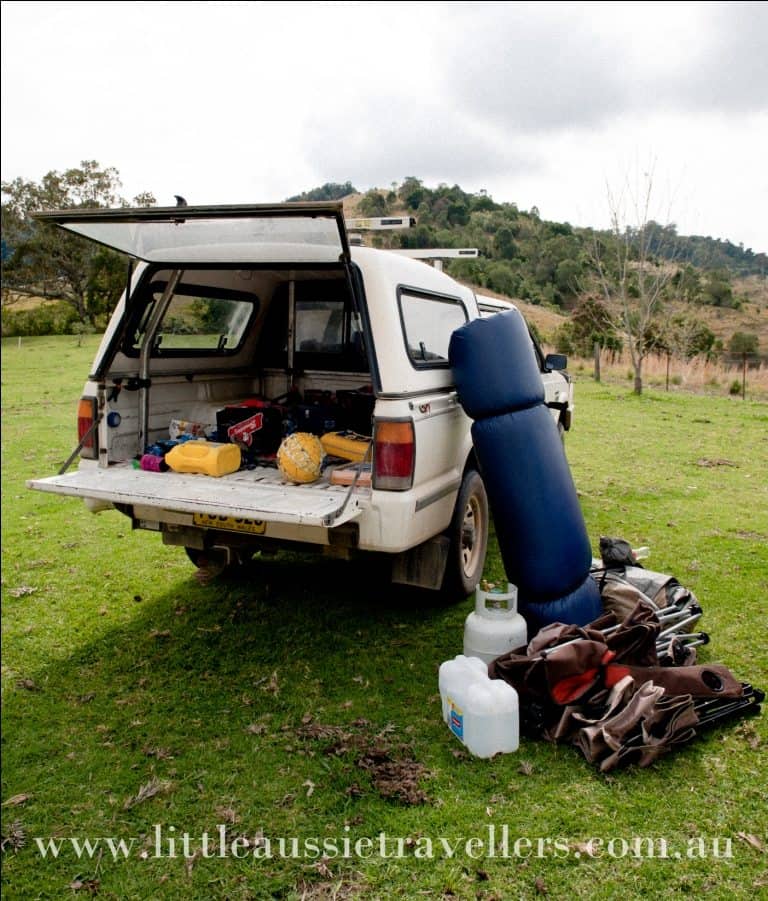
by Loreena Walsh | Camping, Places To Stay
If your family is anything like ours, then there’s nothing like the sound of a free family holiday to get the excitement happening! Of course in reality, while no holiday is truly free, it helps to have free accommodation to lessen the burden and allow money to be spent on fun activities instead of high priced accommodation.
Free camping exists in some wonderful places around Australia and is a wonderful option for an Australian family adventure, and one that is overlooked by many holiday makers. Free camps offer the perfect way opportunity for families to stretch their holiday budget further and allow them to stay longer, or experience tourist attractions they may not otherwise be able to afford.
Sounds wonderful right? It really is, so if you’re keen to set off and grab a free campsite for your next family vacation then here’s some things to consider.
1. Pre-Planning your Free Camping Holiday
 Just like any other type of holiday, if you’re going to free camp you’ll need to pre-plan. The trick with free camping is knowing where the free camps are. In truth, there has been pressure in many high tourist areas to close free or budget camps, mostly driven by caravan parks who, like everyone else are feeling the pinch within their business. Not to worry though, there are still a whole lot of free camping options, but you’ll just need a little help to find the best of them.
Just like any other type of holiday, if you’re going to free camp you’ll need to pre-plan. The trick with free camping is knowing where the free camps are. In truth, there has been pressure in many high tourist areas to close free or budget camps, mostly driven by caravan parks who, like everyone else are feeling the pinch within their business. Not to worry though, there are still a whole lot of free camping options, but you’ll just need a little help to find the best of them.
The most recommended book among travel circles is Camps Australia Wide. The current version in early 2012 is Camps 6 with a new version due out around March 2013 and every couple of years continually.
The best option is to grab a copy of this book (it’s a great investment and they hold their resale value too) take a look at the region you’re thinking of travelling to and note all the available sites, or at least find a region that has free camping, as some regions are very limited. The best thing about having a book like this on hand is that you’ll know before you arrive, what facilities are available and if you feel it will be suitable for your camping style, ability and interests.
2. Having the Right Gear to go Free Camping
What gear you’ll need to have a successful camping adventure is very dependent on the type of camping ground you’ll be staying at. It’s important to understand the facilities that exist and prepare accordingly. Just like our guide to buying a family tent, choosing the gear you’ll need for free camping depends highly on the type, location and facilities at the camp site.
Yes, it’s true you can go free camping with just a tent and some basic supplies. In fact, we do just that on a regular basis, and have a great time, the key is understanding your own needs, expectations and making the most of the available facilities. It is important to have your own options for showers/baths if there aren’t any available on site. A porta-loo is also a necessary option if there’s no available toilets. For more avid campers this type of gear is often already on hand, for families with limited camp gear, choose a site with options such as showers and toilets. Sometimes you’ll have to pay a minimal charge for a hot shower, but it will be well worth it.
3. Communication in Free Camps
Most people own a mobile phone and rely on it as their contact method with friends and family or emergency help when out travelling. It’s super important to know the coverage for your mobile phone service if you’re travelling to more remote free camping areas. Chances are that there may be little or no phone reception, so if you don’t have a CB radio, it pays to at least let someone know where you’re going. Often you won’t be camping alone and there’s generally other campers close by, but don’t rely on it. For the most part you won’t need phone contact if you’re out of service, but it’s just good measure to understand if this is the case.
4. Main Points to Consider for Free Camping
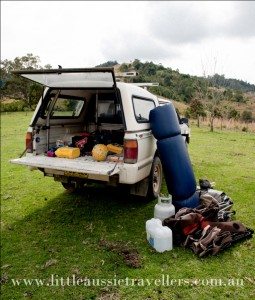 Water Availability: Many free camps are more remote and rely on bore water if they even have water available at all. It’s always wise to carry your own water when camping so keep this in mind
Water Availability: Many free camps are more remote and rely on bore water if they even have water available at all. It’s always wise to carry your own water when camping so keep this in mind
Fires and BBQ’s: If you’re staying in a National Park area you won’t be allowed to collect firewood and will need to bring your own. Similarly if there are fire bans in place then open fires are not allowed. Having a gas cooktop in these instances is always a bonus.
Time Limits: Some camp sites only allow limited stays. Be sure to follow any rules in regards to this as you can face fines in some instances, but more importantly, the rules are there to be sure that all visitors to the area have availability to resources. Campers causing problems by ignoring limits and other rules sometimes are the cause of free sites being closed, so it pays to be respectful.
Rubbish: There are no rubbish collection services at many free camp sites. This makes sense because rubbish services cost money, so if you’re not paying or you’re only paying minimal charges, and there are no bins then have respect and take your rubbish with you. Like other problems caused by disrespectful campers,, excess rubbish being left around campsites has forced closure of many sites around Australia.
5. Be Respectful:
Free campsites are a privelege, and sadly misuse or abuse of available facitilies has caused many closures in recent years. Keep it simple, don’t abuse available services, be respectful of the surroundings and other campers, stay tidy and clean and leave your campsite as you found it.
In all honesty, just get out there and have fun. If you’re not used to camping, then start out in a free camp or budget camp that offers great facilities and is close to a town with mobile phone reception, showers and toilets. Grab yourself a copy of Camps 6 and don’t be afraid to test your boundaries by discovering new, more remote places once in a while.
Got Questions? Please ask us below. Got Tips? Please add them to the comments below, we’d love to hear from you!
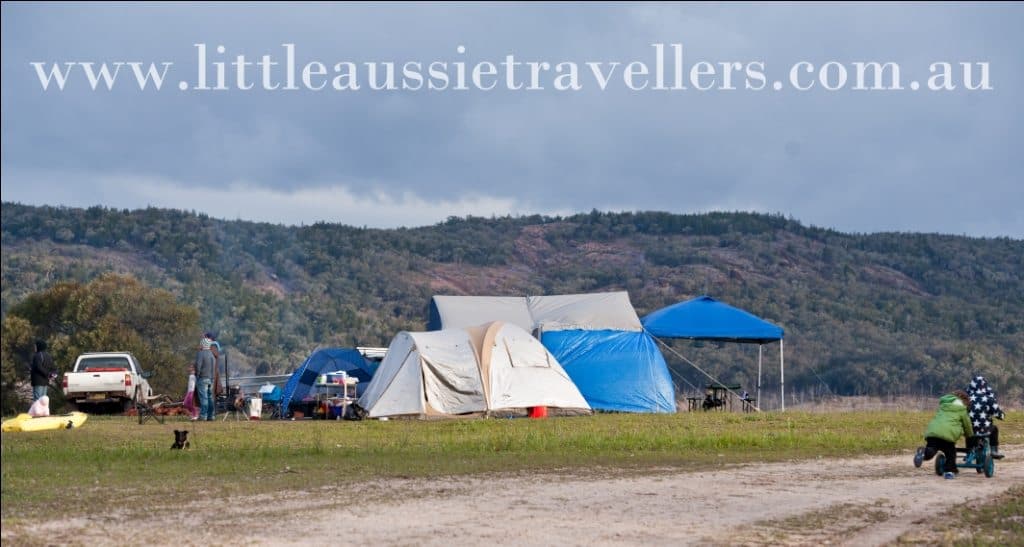
by Loreena Walsh | Camping, Gear Guide
If you’re a family looking for adventure, keen to pitch a tent and explore the great outdoors, then one of the most important things you’ll need to know is how to choose a family tent to be used as your home away from home. Deciding on the right tent is something that should be done with planning, consideration and research. Be sure to physically look at the tents you’re considering and get a thorough idea of the features and price range available in the tent ranges you’re considering. Not sure where to start? The good news is it’s not as hard to find a great tent as it may seem, if you follow some simple tips.
Many people feel overwhelmed when choosing the right tent, simply because of the large range of options that are available, but, by asking yourself some simple questions, the process of choosing a family tent will become a while lot easier.
1. How Will the Tent Be Used?
This may sound like a silly question, the answer is camping, sleeping right? Wrong! Of course those things are true, but there are other important factors that come into play here. Will you be hiking long distances and need to take the tent with you? If so you’ll need to go for compact and light. Will you be staying for extended periods of time? If so then extra space and durability may be necessary. Generally for extended camping trips it’s a much more comfortable experience in a larger tent that has space to stand. Ask yourself what kinds of camping trips you’re likely to be doing and choose a tent that will fit that style well.
2. How Many People Will Be Sleeping in the Tent?
The size of your family will be one of the major deciding factors in the type of tent you purchase. Although do you notice it wasn’t listed in position 1 of the points to consider. That’s because the size of your family won’t always be the major deciding factor in the type of tent. For example, for trips that require a plane flight to get to your destination, or require hiking on foot, a lighter more compact tent is needed. So in this case, even a family of 5 may decide they can squeeze into a 4 man tent for short stays. However if a family loves to camp for weeks on end in one spot, then a 10-12 person multiple room tent may be just what they are looking for. As a rule, the number of people a tent size allocates is for the maximum number of sleeping adults that will fit comfortably. If you’re needing to store clothing etc for 4 people in your tent, then it wouldn’t be wise to buy a 4 person tent (unless for short hiking trips) a family of 4 would more likely look at 6person and above for these purposes.

3. Where and When do Your Family Camping Holidays Take Place?
Going back to the first two points, the next point to consider is the likely location and timing of your camping trips. If you know you will be camping in summer then a tent with great ventilation is an absolute must! Tents with inadequate windows, lack of fly screening and ventilation points will fast become unbearably hot during the Aussie summer heat, so take this into consideration. If you know you’re likely to do some camping during wet periods or areas where there’s high dew levels at night, then it’s vital to have a tent that is waterproof, has zippers that won’t leak and sturdy flooring that won’t allow the water to penetrate. It’s important to understand that even family camping trips can be inundated with all kinds of weather, so tents that offer these features are always a bonus.
4. Budget Vs Quality
When it comes to the final decision for the tent, the reality is, that the tent you purchase will come down to price vs quality. Once you know where you’ll be using your tent and for what purpose, and how many people you need to accommodate with an average time of stay, then the final decision will be the pricing and quality.
There is such a large variety of pricing across tent ranges, but generally with that pricing range comes a huge range in the extra features and also a major difference in quality. For many families, purchasing a top of the range, ultra expensive tent may be out of the question, but be sure at least to look at the top of the range tent with the features that will suit you, then take a look at the bottom of the range. Once you have an idea of what’s on either end of the price scale, it’s wise to go with an option somwhere in between.
5. Finally….
No matter what tent you choose, be sure to hold onto your purchase receipt, as a good tent should come with a warranty period, and be free from defects. Before you head out on your first camping trip with your new tent, it always pays to do a mock setup at home (or let the kids have a camping trip in the backyard) so you get to know how to set the tent up and pack it down. It’s much more fun if you arrive at your campsite knowing how to pitch your tent instead of wasting time trying to figure it out instead of relaxing!
[wp_ad_camp_1]
Now you’ve got your tent sorted, the next decision will be choosing sleep gear for family camping!



